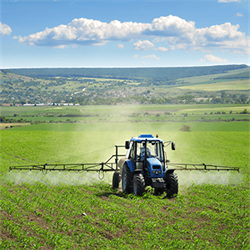 LIQUID MICRONUTRIENTS
LIQUID MICRONUTRIENTS
Hydri-Gro micronutrients from Hydrite provide essential minerals for crops. Our line of micronutrients will ensure that crops reach their fullest potential.
Below are benefits of each of the micronutrients available from Hydrite.
PLANT HEALTH BENEFITS:
Boron
Boron functions within a plant primarily to maintain the integrity of cell wall structures. Cross links occur between cell wall sugars by boron linkages - important for cell elongation, retention of cellular calcium, and regulation of H+ transport. Evidence further suggests that boron plays significant roles in various cell functions and plant hormone response.
Boron is also essential for the transportation of photosynthetic sugars to the rapidly developing meristematic tissues. Boron deficiency causes deformity of actively growing regions. Symptoms include cessation of terminal bud grow, black necrosis of young leaves, and stiffing of stems.
Calcium
Calcium is essential to cell wall membrane structure and permeability, it neutralizes the organic acids formed during normal cell metabolism, and is important to nitrogen metabolism and protein formation by enhancing nitrate (NO3-) uptake. Furthermore, calcium is vital for cell elongation and division and the translocation of carbohydrates and nutrients.
Calcium deficiency weakens cell membranes, reduces the development of roots and shoots causing growth to cease, and causes failure of the nutrient uptake mechanisms. The accumulation of carbohydrates in the leaves under low calcium conditions impairs normal root function. This ultimately causes deformed tissues and death of growth points including buds, blossoms, and root tips.
Copper
Copper is primarily associated with enzymes involved in redox reactions, otherwise known as electron transport reactions. The reduction of CO2 to carbohydrates photosynthesis—and the oxidation of carbohydrates to CO2—respiration—involve electron transfers that require copper. Through these processes adenosine triphosphate (ATP) is synthesized; ATP is the primary energy source for the synthesis of proteins, lipids, cell wall membranes, and active nutrient uptake.
Copper deficiency during vegetative growth impedes photosynthesis slowing carbohydrate production reducing plant growth. Further deficiency during reproductive growth causes the accumulation of carbohydrates impeding pollination and seed set. Chlorosis in young leaves is a common symptom and as the deficiency advances young leaves turn pale and older leaves suffer necrosis.
Iron
Iron is a key element of enzymes and molecules that are involved in the redox reactions of respiration and photosynthesis. Several of these iron containing enzymes are also required for chlorophyll synthesis. Nitrogenase, the enzyme necessary for nitrogen fixation, contains iron.
The characteristic symptom of iron deficiency is intervenous chlorosis—yellowing between veins—resulting from the reduced production of chlorophyll. Appearing initially on younger leaves and progressing rapidly throughout the entire leaf, as iron is immobile within the plant. Under severe or prolonged deficiency the veins may become chlorosis causing the whole leaf to turn white and necrotic.
Magnesium
Magnesium is a primary constituent of chlorophyll—photosynthesis would not occur without chlorophyll, associated with transfer reactions involving phosphate reaction groups, and required for maximum activity of carbohydrate converting enzymes. Magnesium also serves a structural component in ribosomes. Magnesium deficiency symptoms often appears first on lower leaves because it is readily translocated from older to newer growth. Interveinal chlorosis—yellowing between veins--leaves occurs in many plants with magnesium deficiency. Sever deficiency leads to leaf tissues becoming homogeneously yellow to death.
Manganese
Manganese is vital for photosynthesis reactions, enzyme activation, and root growth. The most essential functions of manganese are the production of oxygen (O2) from water and the reduction of CO2 to carbohydrates during photosynthetic reactions. Manganese is also responsible activating several key enzymes that synthesize amino acids important to the formation of lignin, along with the synthesis of compounds that provide resistance to infection.
Manganese is immobile within the plant; therefore, interveinal chlorosis—yellowing between veins—is initially observed in younger leaves with manganese deficiency. However, it can also occur in older leaves depending on plant species and growth stage. Further symptoms of deficiency include substantial reduction of root and shoot growth rates and the heighten potential for root and leaf diseases.
Zinc
Zinc is required by plants for many enzymatic activities and is involved in the biosynthesis of chlorophyll. Zinc is also important for the synthesis of tryptophane, an amino acid found in some proteins and required for the production of auxins—growth regulating hormones—including indole-3-acetic acid (IAA).
Zinc deficiency is identifiable by the distinct visual symptoms in leaves, fruit, and plant growth. Common symptoms include older leaves become yellow between the veins leading to tissue death, the reduction of internodal growth resulting in the characteristic rosette growth, and the malformation of leaves and fruits—often producing little to no yield.